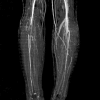Hypereosinophilia presenting as eosinophilic vasculitis and multiple peripheral artery occlusions without organ involvement
- PMID: 16100465
- PMCID: PMC2782169
- DOI: 10.3346/jkms.2005.20.4.677
Hypereosinophilia presenting as eosinophilic vasculitis and multiple peripheral artery occlusions without organ involvement
Abstract
We report here a case with hypereosinophilia and peripheral artery occlusion. A 32-yr-old Korean woman presented to us with lower extremity swelling and pain. Angiography revealed that multiple lower extremity arteries were occlusive. The biopsy specimen showed perivascular and periadnexal dense eosinophilic infiltration in dermis and subcutaneous adipose tissue. Laboratory investigations revealed a persistent hypereosinophilia. She was prescribed prednisolone 60 mg daily. Her skin lesion and pain were improved and the eosinophil count was dramatically decreased. After discharge, eosinophil count gradually increased again. Cyanosis and pain of her fingers recurred. She had been treated with cyclophosphamide pulse therapy. Her eosinophilia was decreased, but the cyanosis and tingling sense were progressive. The extremity arterial stenoses were slightly progressed. Skin biopsy showed perivascular eosinophilic infiltration in the dermis and CD40 ligand (CD40L) positive eosinophilic infiltration. The serum TNF-alpah was markedly increased. These results suggest that CD40L (a member of TNF-alpah superfamily) could play a role in the inflammatory processes when eosinophil infiltration and activation are observed. We prescribed prednisolone, cyclophosphamide, clopidogrel, cilostazol, beraprost and nifedipine, and she was discharged.
Figures





References
-
- Bain BJ. Hypereosinophilia. Curr Opin Hematol. 2000;7:21–25. - PubMed
-
- Mohri H, Motomura S, Okubo T. Unusual leukocytosis with eosinophilia by an allergic disease. Am J Hematol. 1998;57:90–91. - PubMed
-
- Kim JC, Lee SK, Kim YG, Moon IS, Kim SN, Koh YB. Hypereosinophilic syndrome accompanied by digital necrosis. J Korean Surg Soc. 2000;58:740–744.
-
- Yomoda M, Inoue M, Nakama T, Mori O, Chen KR, Hashimoto T. Cutaneous eosinophilic vasculitis associated with rheumatoid arthritis. Br J Dermatol. 1999;140:754–755. - PubMed
-
- Hachulla E, Hatron PY, Janin A, Robert Y, Devulder B. Digital arteritis, thrombosis and hypereosinophilic syndrome: an uncommon complication. Rev Med interne. 1995;16:434–436. - PubMed
Publication types
MeSH terms
Substances
LinkOut - more resources
Full Text Sources
Medical
Research Materials

